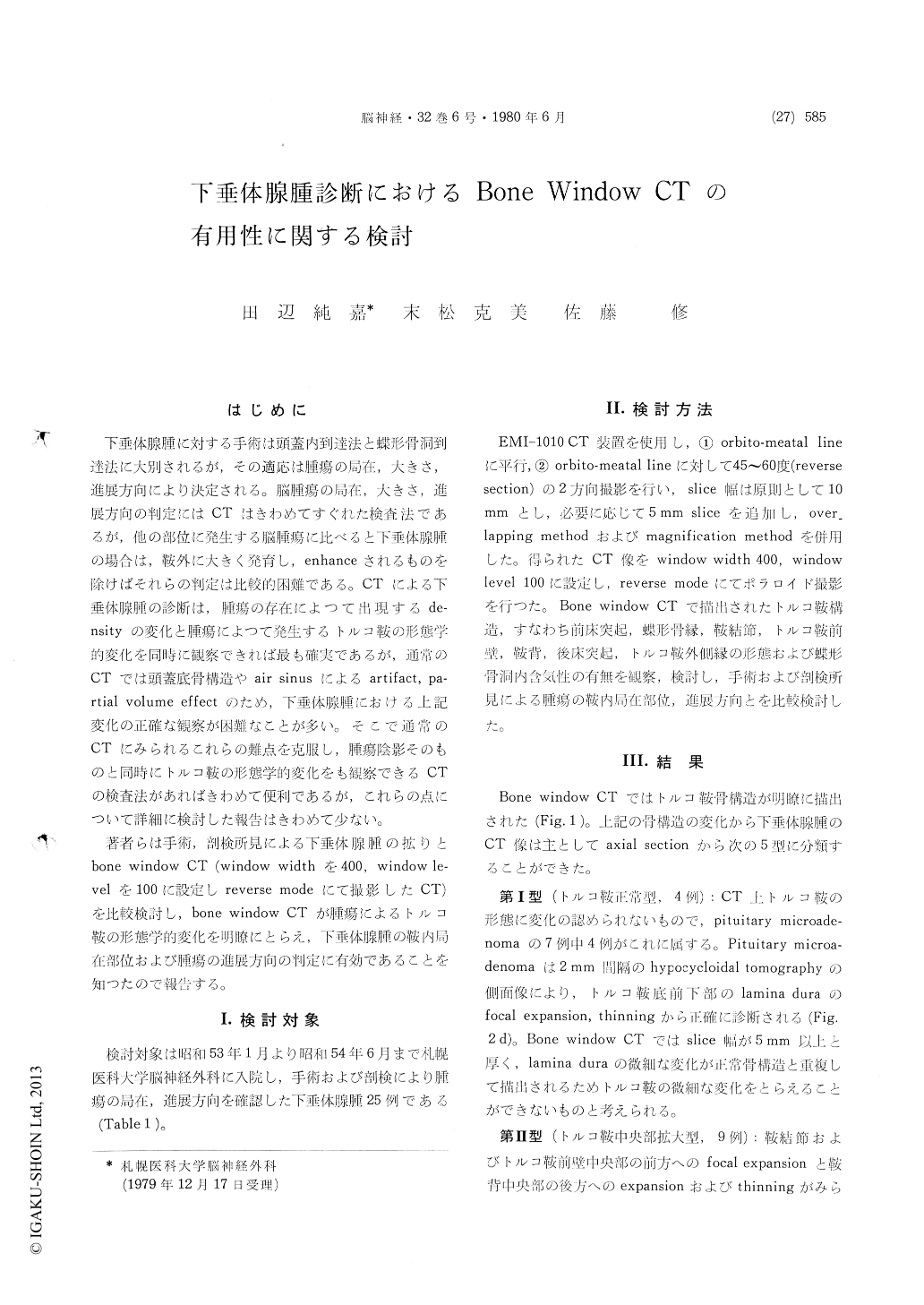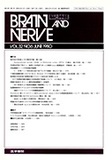Japanese
English
- 有料閲覧
- Abstract 文献概要
- 1ページ目 Look Inside
はじめに
下垂体腺腫に対する手術は頭蓋内到達法と蝶形骨洞到達法に大別されるが,その適応は腫瘍の局在,大きさ,進展方向により決定される。脳腫瘍の局在,大きさ,進展方向の判定にはCTはきわめてすぐれた検査法であるが,他の部位に発生する脳腫瘍に比べると下垂体腺腫の場合は,鞍外に大きく発育し,enhanceされるものを除けばそれらの判定は比較的困難である。CTによる下垂体腺腫の診断は,腫瘍の存在によつて出現するde—nsityの変化と腫瘍によつて発生するトルコ鞍の形態学的変化を同時に観察できれば最も確実であるが,通常のCTでは頭蓋底骨構造やair sinusによるartifact, pa—rtial voiume effectのため),下垂体腺腫における上記変化の正確な観察が困難なことが多い。そこで通常のCTにみられるこれらの難点を克服し,腫瘍陰影そのものと同時にトルコ鞍の形態学的変化をも観察できるCTの検査法があればきわめて便利であるが,これらの点について詳細に検討した報告はきわめて少ない。
著者らは手術,剖検所見による下垂体腺腫の拡りとbone window CT (window widthを400, window le—velを100に設定しreverse modeにて撮影したCT)を比較検討し,bone windQw CTが腫瘍によるトルコ鞍の形態学的変化を明瞭にとらえ,下重体腺腫の鞍内局在部位および腫瘍の進展方向の判定に有効であることを知つたので報告する。
CT scan is useful for the diagnosis of pituitary adenomas when they are well enhanced and show remarkable suprasellar extension. But the deformi-ties or the destructions of the sella turcica by pituitary adenomas are not well demonstrated by the conventional CT scan because of the artifacts or the partial volume effect elicited by the sur-rounding bony structures.
To overcome these difficulties, the authors have developed the bone window CT scan which demon-strates not only the soft tissue of the tumor butalso the bony changes of the sella turcica. The bone window CT scan means the CT scan by the reverse mode display method with the window width in 400 and the window level at 100.
We analysed 25 cases of the sella turcica in pituitary adenomas by the bone window CT scan in both axial and coronal sections.
From the deformities of the sella turcica, we classified five types of sellar changes in pituitary adenomas.
Type I: normal sella. Four of seven pituitary microadenomas were included in this type.
Type II: central enlargement of the sella. Only the central portion of the tuberculum sellae or anterior wall of the sella and the central portion of the dorsum sellae were eroded and thinned and the tumor was located in the center of the sella turcica with occasional suprasellar or sphenoidal extension but without lateral extension of the tumor.
Type III: diffuse enlargement of the sella. The anterior-posterior diameter of the sella was equally increased and the tuberculum sellae, anterior wall of the sella and the dorsum sellae were diffusely thinned. The localization of the tumor in this type was similar to type II but the size of the tumor was larger in this type.
Type IV: lateral enlargement of the sella. Unilateral anterior-posterior diameter of the sella was increased and the tumor was dislocated to the enlarged side of sella. This type was further sub-divided into two groups. In group 1, the posterior clinoid process was not destructed and the tumor was confined within the lateral margin of the sella. In group 2, the posterior clinoid process was destructed and the tumor extended beyond the lateral margin of the sella.
Type V: diffuse destruction of the sella. The sella was widely and markedly destructed with its surrounding structures such as the clivus, the middle cranial fossa and the sphenoid sinus. The tumor extended in all directions beyond the destructed sellar margins.
The bone window CT scan proved to be useful for the detection of not only the tumor mass but also the deformities of the sella. From the findings of the sellar deformities, the intrasellar location and the mode of extrasellar extension of the pituitary adenomas were defined.

Copyright © 1980, Igaku-Shoin Ltd. All rights reserved.


